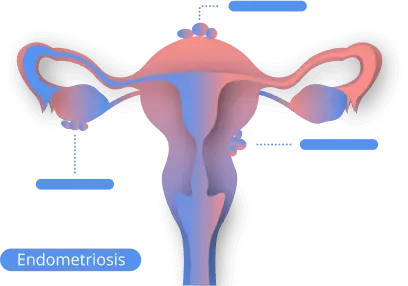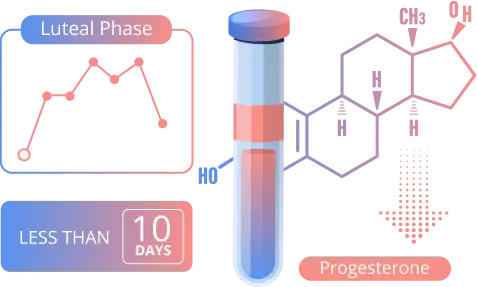Unexplained Infertility
Unexplained Infertility is frustrating, we can help. Talk to a doctor to get started.
In couples who undergo evaluation for infertility, about 30% will be diagnosed with unexplained infertility. The problem is defined as the lack of an obvious cause for a couple's infertility and inability to get pregnant after at least 12 cycles of unprotected intercourse or after six cycles in women above 35 years of age for whom all the standard evaluations are normal.
Couples with unexplained infertility have high chances of getting pregnant naturally within a year following diagnosis. We prefer the term "undiagnosed infertility", because a significant proportion of women and couples with what is called unexplained infertility can actually get a diagnosis with further investigation.
Studies show women with undiagnosed infertility may suffer from one of two conditions that lead to a decreased probability of pregnancy.
Endometriosis

Endometriosis is an inflammatory condition in which endometrial cells implant in the pelvis, are not cleared by the immune system, and cause an inflammatory response responsible for deceased egg quality, abnormal tubal function, and decreased probability of embryo implantation.
Newer testing is available that evaluates intrauterine biomarkers of endometriosis and has demonstrated that a higher percentage of patients with unexplained infertility will test positive – meaning that their infertility is not unexplained (undiagnosed) but is secondary to endometriosis. Surprisingly, some of these women will not have typical symptoms of endometriosis such as painful periods, pelvic pain or abnormal bleeding, and the only manifestation of their “silent endometriosis” will be difficulty conceiving.
Luckily, after identification of endometriosis, if treated, with either medicine or surgery to reduce the inflammatory impact of disease, the success rate with fertility intervention is significantly improved.
Luteal Phase Deficiency (LPD)

Luteal Phase Deficiency (LPD) is a controversial concept; and encompasses the theory of inadequate progesterone secretion – either the quantity or duration, or progesterone resistance at the level of the endometrium. Clinical signs of LPD are a short luteal phase – typically less than 10 days, or premenstrual spotting – without identified anatomic abnormalities such as polyps or fibroids.
Although there are no established criteria available for diagnosis, there is an FDA approved home test for pregnanediol glucuronide (PDG), a progesterone metabolite, that if negative, despite all other signs of ovulation, can be helpful in the diagnosis. Although every case is different and approached on an individual basis, we do recommend luteal phase progesterone support to our patients with unexplained infertility and especially to those where we suspect LPD.
These conditions can be found after completion of an evaluation demonstrating ovulatory status, normal ovarian reserve, at least one patent tube in the female, and an adequate number of motile sperm with normal sperm morphology in the male.

How we can help:
The initial treatments for unexplained infertility are ovarian stimulation (OS) with timed intercourse and/or intrauterine insemination (IUI). Typically, the first medications tried for OS are clomiphene (Clomid) or letrozole (Femara). These medications are intended to increase the number of ovulated eggs and boost the monthly pregnancy rate. Most studies demonstrate Letrozole and Clomid are equivalent in their efficacy. Most pregnancies occurring on these medicines happen within the first three months.
Our approach, at Fertility Cloud, is to start with either Letrozole or Clomid, depending on the clinical history. We then treat our patient for three months. If not successful, we take additional treatments.
If endometriosis is suspected, it is our common practice to recommend and refer our patients for endometriosis testing and / or surgery after an unsuccessful initial course of OS.
In-Vitro-Fertilization (IVF) is, statistically, the most successful treatment for unexplained infertility, however, it may not be the best option and may not be acceptable or affordable to some patients. Additional testing may provide answers to a percentage of patients and provide a directed approach allowing some patients to avoid IVF.
Case Study
Unexplained infertility case study
The following stories are real. Keep in mind that you should not take it as treatment advice. Your case can be individual.
"We would like to introduce to you the story of Alice (name changed for the purposes of this article). Alice is a patient that came to us with the diagnosis of unexplained (undiagnosed) infertility. Alice had an evaluation that demonstrated normal ovarian reserve, her AMH was 3.58 ng/mL (the lab norm is from 1 to 7.6 ng/mL), her fallopian tubes were open as documented by a hysterosalpingogram test and her spouse’s sperm evaluation was completely normal. In addition, her male partner had two prior children from a previous relationship.
Alice had been trying to conceive for over fourteen months prior to seeking care with us. She underwent a few cycles of letrozole and then underwent IVF and did not get pregnant with a frozen embryo transfer. After seeing her through our, always accessible, telehealth platform, we realized that Alice likely suffers from LPD. We discussed additional testing for monitoring and confirmed our suspicions.
We discussed her treatment options, and she underwent ovarian stimulation and progesterone support and got pregnant on her second treatment cycle. She was ecstatic, as her experience at FC allowed her to be successful and receive an answer to the question that has been unanswered for a long time providing much needed closure in a much more affordable manner.
******
We know undiagnosed infertility is frustrating. Newer management strategies and additional testing can provide answers and improve your prognosis.
We look forward to assisting all couples who are just starting or have been given the diagnosis of unexplained infertility maximize their chances of conception.